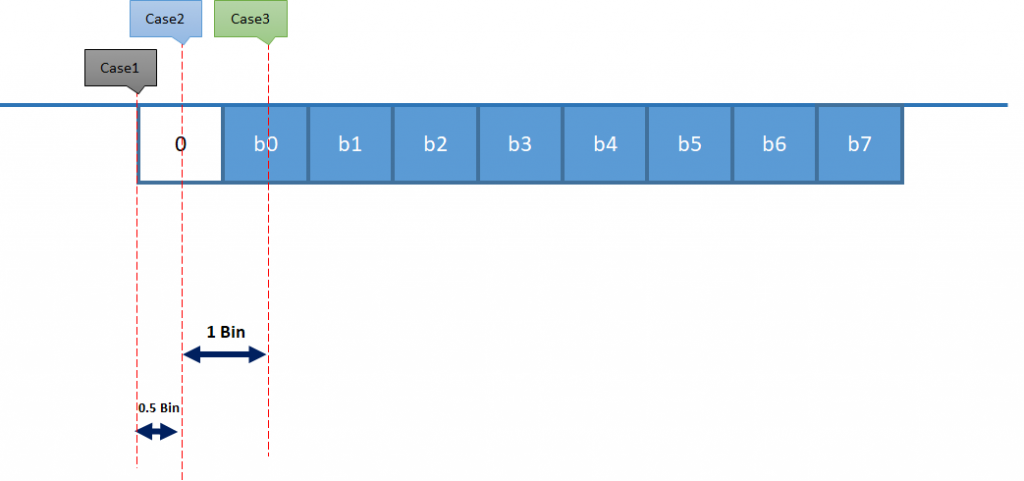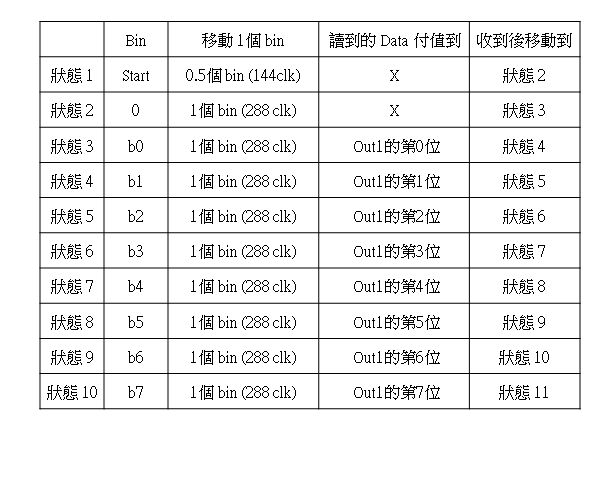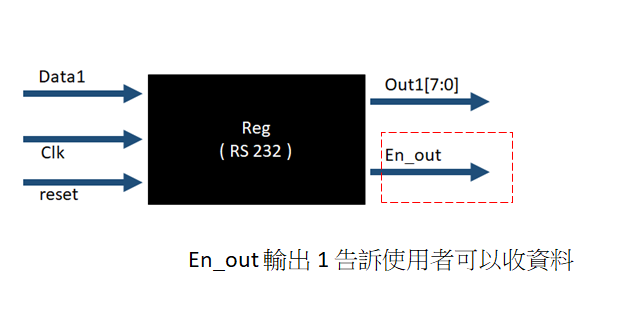狀態3 b0 的設定
昨天講到狀態3 b0 的設定

3:
begin
if(Count_clk >= 287 ) begin
Count_clk<=0;
Out1[0] <=Data;
State1 <= 4;
end
else begin
Count_clk<=Count_clk+1;
end
end
狀態4 b1 的設定
其實到 狀態4 一樣是
移動 1個 bin → 287 clk
讀到的 Data 付值到 Out1的第1位
收到後移動到 State 5
移動 1個 bin → 287 clk
if(Count_clk >= 287 ) begin
Count_clk<=0;
end
else begin
Count_clk<=Count_clk+1;
end
if(Count_clk >= 287 ) begin
Count_clk<=0;
Out1[0] <=Data;//讀到的 Data 付值到 Out1的第1位
end
else begin
Count_clk<=Count_clk+1;
end
if(Count_clk >= 287 ) begin
Count_clk<=0;
Out1[0] <=Data;
State1 <= 5; //收到後移動到 State 5
end
else begin
Count_clk<=Count_clk+1;
end
狀態5 ~ 10 → b2 ~ b7 的設定

直接寫結果吧:
module Rs232_test1(Data1,clk,reset1,Out1,En_out);
input Data1,reset1 ,clk;
output[7:0] Out1;
output En_out;
reg[7:0] State1;
reg[7:0] Count_clk;
reg[7:0] Count_bin;
// 所以 Out1 是個 reg
reg[7:0] Out1;
reg[7:0] Data_Previous1;
always@(negedge reset1 or posedge clk)
begin
if( ~reset1) begin
//設定為 Reg 就要馬上給他初始化
Out1<=0;
Count_clk<=0;
Count_bin<=0;
Data_Previous1<=0;
State1 <=0;
end
else begin
Data_Previous1 <= Data1;
case (State1)
0:
begin
if(Count_clk >= 287 ) begin
Count_clk<=0;
end
else begin
Count_clk <= Count_clk + 1;
end
if(Count_clk == 0 )begin
if(Data1==1)begin
Count_bin <= Count_bin+1;
end
else begin
Count_bin <= 0;
end
end
if(Count_bin== 15 )begin
State1 <= 1;
end
end
1:
begin
if(~Data_Previous1 & Data1 ) begin
State1 <= 2;
end
end
2:
begin
if(Count_clk >= 143 ) begin
Count_clk<=0;
State1 <= 3;
end
else begin
Count_clk<=Count_clk+1;
end
end
3:
begin
if(Count_clk >= 287 ) begin
Count_clk<=0;
Out1[0] <=Data;
State1 <= 4;
end
else begin
Count_clk<=Count_clk+1;
end
end
4:
begin
if(Count_clk >= 287 ) begin
Count_clk<=0;
Out1[1] <=Data;
State1 <= 5;
end
else begin
Count_clk<=Count_clk+1;
end
end
5:
begin
if(Count_clk >= 287 ) begin
Count_clk<=0;
Out1[2] <=Data;
State1 <= 6;
end
else begin
Count_clk<=Count_clk+1;
end
end
6:
begin
if(Count_clk >= 287 ) begin
Count_clk<=0;
Out1[3] <=Data;
State1 <= 7;
end
else begin
Count_clk<=Count_clk+1;
end
end
7:
begin
if(Count_clk >= 287 ) begin
Count_clk<=0;
Out1[4] <=Data;
State1 <= 8;
end
else begin
Count_clk<=Count_clk+1;
end
end
8:
begin
if(Count_clk >= 287 ) begin
Count_clk<=0;
Out1[5] <=Data;
State1 <= 9;
end
else begin
Count_clk<=Count_clk+1;
end
end
9:
begin
if(Count_clk >= 287 ) begin
Count_clk<=0;
Out1[6] <=Data;
State1 <= 10;
end
else begin
Count_clk<=Count_clk+1;
end
end
10:
begin
if(Count_clk >= 287 ) begin
Count_clk<=0;
Out1[7] <=Data;
State1 <= 11;
end
else begin
Count_clk<=Count_clk+1;
end
end
11:
begin
if(Count_clk >= 287 ) begin
Count_clk<=0;
// 讀到的 Data 付值到 Out1的第0位
Out1[0] <=Data;
State1 <= 12;
end
else begin
Count_clk<=Count_clk+1;
end
end
default:
begin
end
endcase
end
end
endmodule
告訴使用者可以收訊號了
如何告訴使用者可以收資料呢 En_out 變成 1 阿

1.設定 En_out 為reeg
2.En_out 變成 1
3.輸出0.5個 bin 的時間好了 144 clk
4.關掉 En_out 變成 0
5.跳回狀態1
6.狀態1 En_out 初始 0
1.設定 En_out 為reeg
老樣子En_out是 Reg
reg En_out
定義 Reg 就初始化
if( ~reset1) begin
//設定為 Reg 就要馬上給他初始化
Out1<=0;
En_out <=0;
Count_clk<=0;
Count_bin<=0;
Data_Previous1<=0;
State1 <=0;
end
2.En_out 變成 1
12:
begin
En_out <= 1;
end
3.輸出0.5個 bin 的時間好了 144 clk
12:
begin
if(Count_clk >= 287 ) begin
Count_clk<=0;
end
else begin
En_out <= 1; //En_out 變成 1
Count_clk<=Count_clk+1;
end
end
4.關掉 En_out 變成 0
12:
begin
if(Count_clk >= 287 ) begin
Count_clk<=0;
En_out <= 0;
end
else begin
En_out <= 1;
Count_clk<=Count_clk+1;
end
end
5.跳回狀態1
12:
begin
if(Count_clk >= 287 ) begin
Count_clk<=0;
En_out <= 0;
State1 <= 1;
end
else begin
En_out <= 1;
Count_clk<=Count_clk+1;
end
end
6.狀態1 En_out 初始 0
1:
begin
if(~Data_Previous1 & Data1 ) begin
En_out <= 0;
State1 <= 2;
end
end
放進程式碼吧
module Rs232_test1(Data1,clk,reset1,Out1,En_out);
input Data1,reset1 ,clk;
output[7:0] Out1;
output En_out;
reg[7:0] State1;
reg[7:0] Count_clk;
reg[7:0] Count_bin;
// 所以 Out1 是個 reg
reg[7:0] Out1;
// 所以 En_out 是個 reg
reg En_out;
reg[7:0] Data_Previous1;
always@(negedge reset1 or posedge clk)
begin
if( ~reset1) begin
//設定為 Reg 就要馬上給他初始化
Out1<=0;
//設定為 Reg 就要馬上給他初始化
En_out <= 0;
Count_clk<=0;
Count_bin<=0;
Data_Previous1<=0;
State1 <=0;
end
else begin
Data_Previous1 <= Data1;
case (State1)
0:
begin
if(Count_clk >= 287 ) begin
Count_clk<=0;
end
else begin
Count_clk <= Count_clk + 1;
end
if(Count_clk == 0 )begin
if(Data1==1)begin
Count_bin <= Count_bin+1;
end
else begin
Count_bin <= 0;
end
end
if(Count_bin== 15 )begin
State1 <= 1;
end
end
1:
begin
if(~Data_Previous1 & Data1 ) begin
En_out <= 0;
State1 <= 2;
end
end
2:
begin
if(Count_clk >= 143 ) begin
Count_clk<=0;
State1 <= 3;
end
else begin
Count_clk<=Count_clk+1;
end
end
3:
begin
if(Count_clk >= 287 ) begin
Count_clk<=0;
Out1[0] <=Data;
State1 <= 4;
end
else begin
Count_clk<=Count_clk+1;
end
end
4:
begin
if(Count_clk >= 287 ) begin
Count_clk<=0;
Out1[1] <=Data;
State1 <= 5;
end
else begin
Count_clk<=Count_clk+1;
end
end
5:
begin
if(Count_clk >= 287 ) begin
Count_clk<=0;
Out1[2] <=Data;
State1 <= 6;
end
else begin
Count_clk<=Count_clk+1;
end
end
6:
begin
if(Count_clk >= 287 ) begin
Count_clk<=0;
Out1[3] <=Data;
State1 <= 7;
end
else begin
Count_clk<=Count_clk+1;
end
end
7:
begin
if(Count_clk >= 287 ) begin
Count_clk<=0;
Out1[4] <=Data;
State1 <= 8;
end
else begin
Count_clk<=Count_clk+1;
end
end
8:
begin
if(Count_clk >= 287 ) begin
Count_clk<=0;
Out1[5] <=Data;
State1 <= 9;
end
else begin
Count_clk<=Count_clk+1;
end
end
9:
begin
if(Count_clk >= 287 ) begin
Count_clk<=0;
Out1[6] <=Data;
State1 <= 10;
end
else begin
Count_clk<=Count_clk+1;
end
end
10:
begin
if(Count_clk >= 287 ) begin
Count_clk<=0;
Out1[7] <=Data;
State1 <= 11;
end
else begin
Count_clk<=Count_clk+1;
end
end
11:
begin
if(Count_clk >= 287 ) begin
Count_clk<=0;
// 讀到的 Data 付值到 Out1的第0位
Out1[0] <=Data;
State1 <= 12;
end
else begin
Count_clk<=Count_clk+1;
end
end
12:
begin
if(Count_clk >= 287 ) begin
Count_clk<=0;
En_out <= 0;
State1 <= 1;
end
else begin
En_out <= 1;
Count_clk<=Count_clk+1;
end
end
default:
begin
end
endcase
end
end
endmodule
明天再把 default 寫一寫 就大蓋完成了
